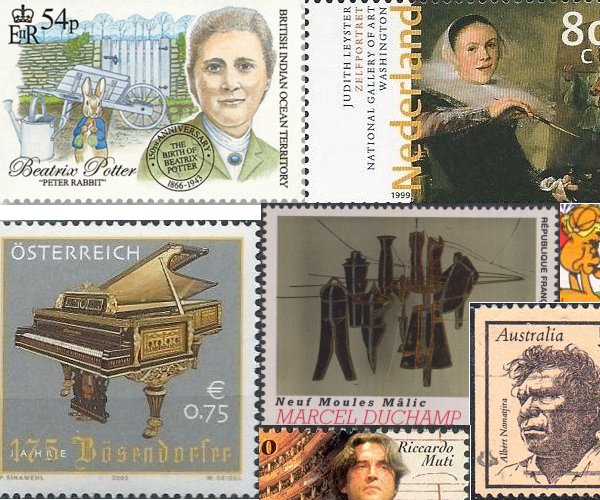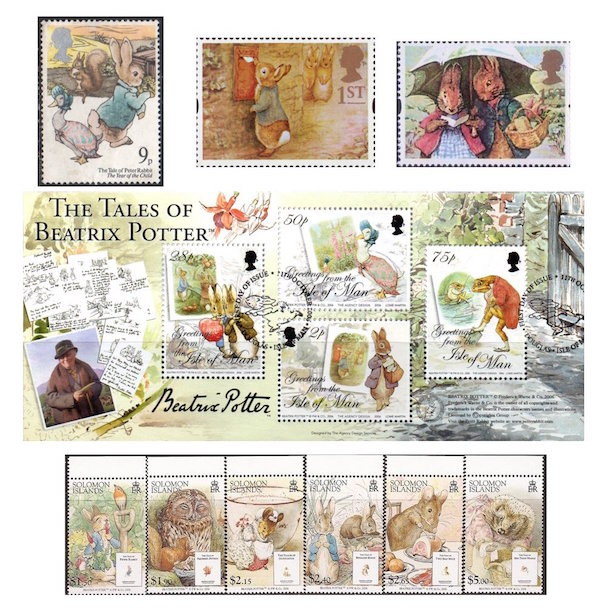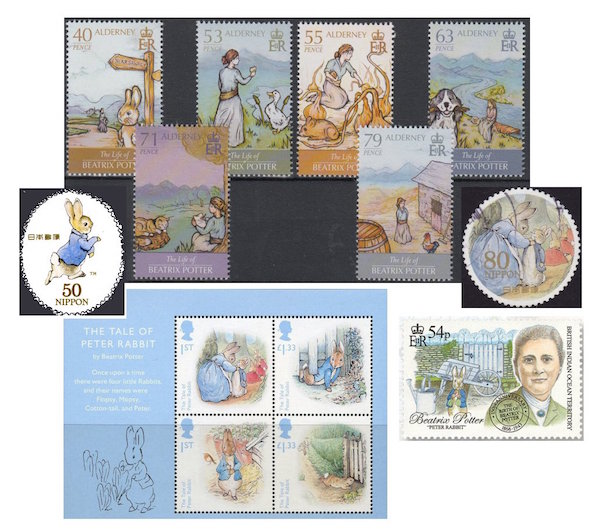The Arts on Stamps of the World — July 28
An Arts Fuse regular feature: the arts on stamps of the world.

By Doug Briscoe
Beatrix Potter (28 July 1866 – 22 December 1943) and her younger brother Bertram had few friends but many pets. Both developed an interest in natural history. Young Beatrix had a gift for recording her observations in drawings, with which she would decorate the family’s greeting cards, once, in 1893, accompanying them with a story about “four little rabbits whose names were Flopsy, Mopsy, Cottontail and Peter”. She published it independently in 1900, and it was taken up by a professional house for reissue in 1902. Greatly successful, it led Potter to create a further two dozen books with her own illustrations. She also cleverly marketed a Peter Rabbit doll and other related “accessories”. In later life she turned more to farming and husbandry, and her purchases of much land for conservation purposes formed the basis of the Lake District National Park. She bequeathed almost all her property to the National Trust. The first stamp on the subject of Peter Rabbit, a British one, appeared in 1979 as part of a set celebrating children’s lit. We’ve now seen the entire set of four, the others being for The Wind in the Willows, Winnie the Pooh, and Alice in Wonderland. Two more Peter Rabbit stamps showed up in 1993, and the 21st century has seen a spate of sheets for both the characters and their creator: the Isle of Man and the Solomons in 2006, Alderney in 2013, and the UK in 2016. Even the British Indian Ocean Territory, which has issued its own postage since 1968, paid tribute with a Beatrix Potter stamp last year for the sesquicentennial. I also show a couple of the Peter Rabbit stamps that have been issued by Japan.


A contemporary of Cervantes, Lope de Vega, and Shakespeare, Spanish playwright Guillén de Castro (1569 – 28 July 1631) was the author of some 35 plays, among them Las Mocedades del Cid (c1605-15), which was used by Corneille for his famous version of the story a few decades later. Another of Castro’s plays was adapted by John Fletcher (as Love’s Cure). Castro in turn made a play, Don Quixote de la Mancha, from parts of Cervantes, and Castro’s representation of one of the characters may have been seen familiar to Shakepeare and Fletcher when they made their now lost version of 1612, Cardenio.
For centuries the paintings of Judith Leyster (or Leijster, born on or around July 28, 1609) were attributed to Frans Hals or to her husband Jan Miense Molenaer. Only in 1893 was the record set straight. Yet she was known to have been a member of the Haarlem Artists’ Guild of St. Luke in 1633, perhaps the first woman to be so admitted. Her marriage to Molenaer followed in 1636. Most of her work was done before her marriage, though a few pieces were executed later. Leyster died on February 10, 1660. Two of her works can be seen on stamps, Young Flute Player (1635) on a Rwandan issue, and Self-Portrait (c1633) on one from Belgium.
The founder of one of the great piano manufacturing houses, Ignaz Bösendorfer, was born on July 28 in the year 1796. He was a carpenter’s son apprenticed to the piano maker Joseph Brodmann, taking over Brodman’s workshop in 1828. On Bösendorfer’s birthday that year he received from the Vienna city administration the concession for his business. Two years later he was official piano maker to the emperor. Ignaz Bösendorfer died on April 14, 1859. The stamp honored the company’s 175th anniversary in 2003.

Russian neoclassicist painter Alexander Ivanov (July 28 [July 16 OS], 1806 – July 15 [July 3 OS], 1858) was admitted to the St. Petersburg Art Academy at the age of 11. Yes, his dad was a professor there, but young Ivanov won two silver and two gold medals for his work. He remained faithful to the classical style even as it passed from fashion. A typical example is his Bellerophon (1829). While visiting Rome he became a friend of Gogol. He spent twenty years (1837–57) working on his Appearance of Christ Before the People, for which he had prepared some three hundred sketches. He returned to Russia in the year of its completion and died of cholera the next year. The old Soviet stamp of 1956 shows Ivanov’s portrait by Sergey Petrovich Postnikov.
Danish painter and illustrator Fritz Syberg (1862 – 20 December 1939) was one of the three most prominent members of the “Funen Painters” group (the others being Peter Hansen and Johannes Larsen. Apart from his paintings, such as The Hill at Overkærby (1917) on a Danish stamp of 1987, he created a set of eighteen large drawings for an edition of Hans Christian Andersen’s The Story of a Mother. A sample can be see here. (Does this sound and/or look familiar? That’s ‘cause I mistakenly included Syberg in my piece for the 26th; his birthday is actually today.)
It’s rare for any individual to be honored on stamps for work in more than one discipline, but such is the case for Marcel Duchamp (28 July 1887 – 2 October 1968), who has several stamps for his art works and one for his ability as a chess player. This is as it should be, since Duchamp’s importance in the art world is much greater than his accomplishments in the Royal Game (though he did achieve the rank of master). Born in Normandy, Duchamp had three siblings who also became successful artists. He and his brother Jacques Villon (whose birthday is in three days) regularly played host to some of the most distinguished artists, such as Robert Delaunay, Fernand Léger, Roger de La Fresnaye, Jean Metzinger, and Juan Gris, in gatherings that came to be known as the Section d’Or. One of Duchamps’ better known works, Nude Descending a Staircase, No. 2 (Nu descendant un escalier n° 2), dates from this period (1912) and is seen on the US stamp. The French one shows the “Malic Molds” portion of his glass sculpture Bride Stripped Bare by Her Bachelors, Even (aka The Large Glass) begun around the same time but not completed until 1923. The two stamps from an Ivoirian souvenir sheet show Paradise, Adam and Eve (c1910) and Transition of Virgin into a Bride (1912). He moved to Greenwich Village in 1942 and became a US citizen in 1955, but there is much more to the fascinating story of this remarkable man, his experiments with “found art”, his explorations of other arts, his supposed retirement from art in pursuit of chess mastery, his devotion to macaronic wordplay, his Rrose Sélavy persona, and on and on.

The Australian Aboriginal artist Albert Namatjira (28 July 1902 – 8 August 1959) was a pioneer of contemporary Indigenous Australian art and the most celebrated of its practitioners. Born Elea Namatjira, he did not turn to a serious career in art until he was in his thirties, when he began producing his landscapes of the Outback. By 1957 he was so respected that he became the first Aboriginal person to receive a restricted form of Australian citizenship, which graciously allowed him to vote and gave him other rare privileges like the legal ability to purchase liquor. Much influenced by Western art, he retained some elements of traditional Aboriginal style. He was honored on an Australian stamp of 1968, and his work appears on a block of four from 1993.
Two orchestra conductors share this July 28 birthday. Eleazar de Carvalho (1912 – 12 September 1996) was a Brazilian conductor who studied at the Berkshire Music Center with Koussevitzky and was Koussie’s conducting assistant at the same time as Leonard Bernstein. Back in Brazil, de Carvalho held principal conducting positions with no fewer than five different orchestras; in the US he was music director of the Saint Louis Symphony Orchestra from 1963 to 1968. He taught at Hofstra and Juilliard and composed opera, symphonic poems, and chamber music.
Our other birthday conductor is Riccardo Muti (born 28 July 1941), who turns 76 today. Back on Zubin Mehta’s birthday (April 28) I posted an image of him (Mehta) on one of the stamps issued by Austria for the annual Vienna New Year’s Concerts. Here is another stamp from that series, issued in 2004, the last time Muti presided over the festivities. (He also conducted the New Year’s Concerts in 1993, 1997, and 2000.) From the same year as the Austrian stamp comes one from the Republic of San Marino—one of a set of three celebrating the completion of the renovations and reopening of La Scala in Milan. Muti was director of La Scala from 1986 to 2005. (We’ll be seeing more La Scala stamps next week.)
The father of Indian actress Leela Naidu (1940 – 28 July 2009) was a scientist who had worked with Marie Curie, and her mother was a French journalist. Leela grew up in Europe and had acting lessons with Jean Renoir. A great beauty, she was painted by Salvador Dalì and appeared on the cover of Vogue in 1954. She starred in only a small number of films, including the first Merchant Ivory production, The Householder (1963), the story for which, by Ruth Prawer Jhabvala, was suggested to them by Naidu. She also made an appearance in their later movie The Guru (1969). Ironically, her last film, an Indian one called Electric Moon (1992), dealt with pretty much the same subject as The Guru. David Lean had wanted to cast her as Tonya in Dr. Zhivago.
Our final subject today is cartoonist Jim Davis (born July 28, 1945), the creator of Garfield. Davis was born in Indiana and still lives there. He had a couple of comic strips prior to the great success of Garfield, which first appeared in 1978. Its international appeal is attested by stamps from the U.S., France, and Madagascar.
Two fine English poets remain stampless, Gerard Manley Hopkins (28 July 1844 – 8 June 1889) and the author of Under the Volcano, Malcolm Lowry (28 July 1909 – 26 June 1957).
A graduate of the University of Massachusetts with a B.A. in English, Doug Briscoe worked in Boston classical music radio, at WCRB, WGBH, and WBUR, for about 25 years, beginning in 1977. He has the curious distinction of having succeeded Robert J. Lurtsema twice, first as host of WGBH’s weekday morning classical music program in 1993, then as host of the weekend program when Robert J.’s health failed in 2000. Doug also wrote liner notes for several of the late Gunther Schuller’s GM Recordings releases as well as program notes for the Boston Classical Orchestra. For the past few years he’s been posting a Facebook “blog” of classical music on stamps of the world, which has now been expanded to encompass all the arts for The Arts Fuse.
